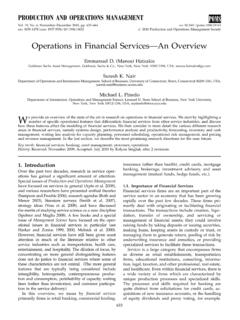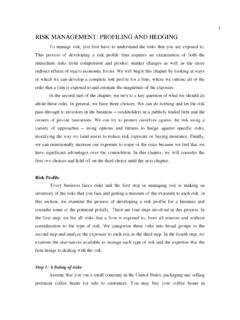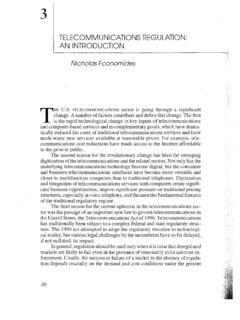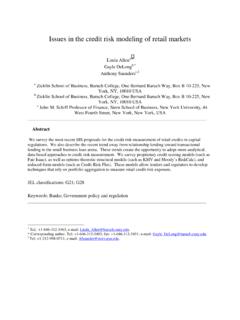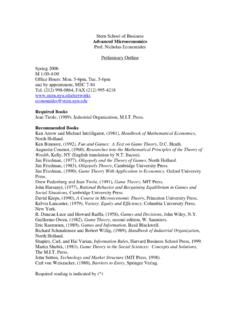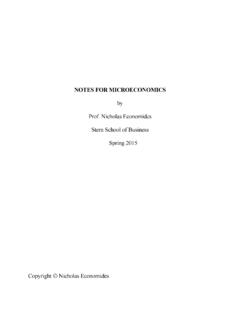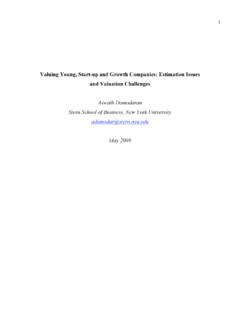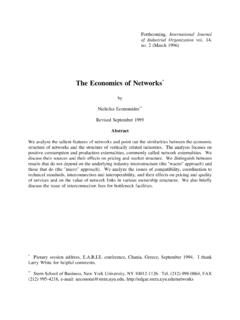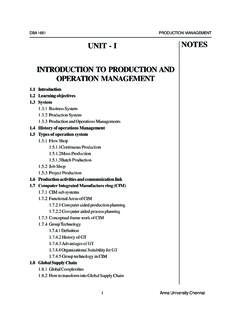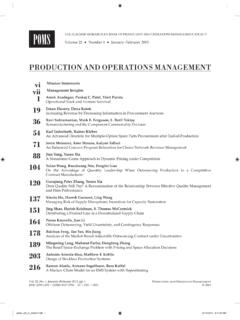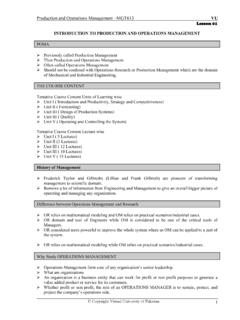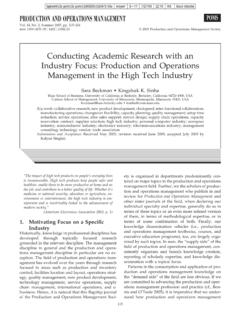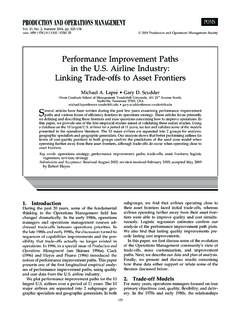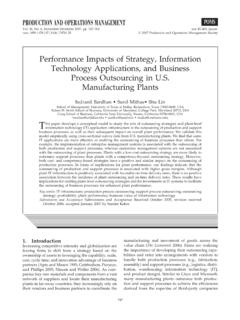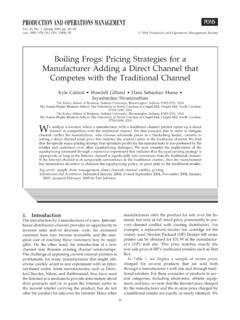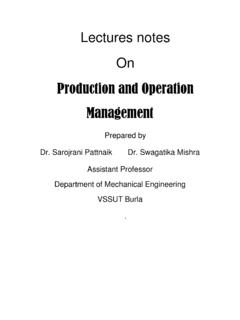Transcription of PRODUCTION AND OPERATIONS MANAGEMENT …
1 The Modern Call Center: A Multi-Disciplinary Perspective on OperationsManagement ResearchZeynep Aksin Mor Armony Vijay MehrotraCollege of Administrative Sciences and Economics, Koc University, Rumeli Feneri Yolu,34450 Sariyer-Istanbul, TurkeyLeonard N. Stern School of Business, New York University, West 4th Street, KMC 8 62, New York,New York 10012, USAD epartment of Decision Sciences, College of Business, San Francisco State University, 1600 Holloway Avenue,San Francisco, California 94132-1722, centers are an increasingly important part of today s business world, employing millions ofagents across the globe and serving as a primary customer-facing channel for firms in manydifferent industries. Call centers have been a fertile area for OPERATIONS MANAGEMENT researchers inseveral domains, including forecasting, capacity planning, queueing, and personnel scheduling.
2 Inaddition, as telecommunications and information technology have advanced over the past several years,the operational challenges faced by call center managers have become more complicated. Issuesassociated with human resources MANAGEMENT , sales, and marketing have also become increasinglyrelevant to call center OPERATIONS and associated academic this paper, we provide a survey of the recent literature on call center OPERATIONS MANAGEMENT . Alongwith traditional research areas, we pay special attention to new MANAGEMENT challenges that have beencaused by emerging technologies, to behavioral issues associated with both call center agents and customers,and to the interface between call center OPERATIONS and sales and marketing.
3 We identify a handful of broadthemes for future investigation while also pointing out several very specific research words: call centers; staffing; skill-based routing; personnel scheduling; outsourcingSubmissions and Acceptance: Submissions and Acceptance: Received April 2007; revision received October2007; accepted October IntroductionVirtually all businesses are interested in providinginformation and assistance to existing and prospectivecustomers. In recent years, the decreased costs of tele-communications and information technology havemade it increasingly economical to consolidate suchinformation delivery functions, which led to the emer-gence of groups that specialize in handling customerphone calls. For the vast majority of these groups,their primary function is to receive telephone calls thathave been initiated by customers.
4 Such OPERATIONS ,known as inbound call centers, are the primarytopic of this call centers are very labor-intensive oper-ations, with the cost of staff members who handlephone calls (also known as agents ) typically com-prising 60 80% of the overall operating budget. In-bound call centers may be physically housed acrossseveral different locations, time zones, or call centers make up a large and growingpart of the global economy. Although reliable in-dustry statistics are notoriously hard to come by, theIncoming Call MANAGEMENT Institute (ICMI), ahighly reputable industry association, regularlytracks published industry statistics from severalsources ( ). By 2008, various studies cited by ICMI predictthe following: The United States will have over 47,000 call cen-ters and million AND OPERATIONS MANAGEMENTVol.
5 16, No. 6, November-December 2007, pp. 665 07 1606 665$ 2007 PRODUCTION and OPERATIONS MANAGEMENT Society665 Europe, the Middle East, and Africa together willhave 45,000 call centers and million agents. Canada and Latin America will have an estimated305,500 and 730,000 agents, , the demand for call center agents in Indiahas grown so fast that the labor supply has beenunable to keep up with it: by 2009, the demand foragents in India is projected to be over 1 million, andmore than 20% of those positions will be unfilledbecause of a shortage of available skilled a customer calls an inbound call center, var-ious call handling and routing technologies will at-tempt to route the call to an available agent. However,there is often no agent available to immediately an-swer the phone call, in which case the customer istypically put on hold and placed in a queue.
6 Thecustomer, in turn, may abandon the queue by hangingup, either immediately after being placed on hold orafter waiting for some amount of time without receiv-ing service. Once connected to an agent, a customerwill speak with that agent for some random time, afterwhich either the call will be completed or the customerwill be handed off to another agent or queue forfurther assistance. The quality of the service is typi-cally viewed as a function of both how long the cus-tomer must wait to receive service and the value thatthe customer attributes to the information and servicethat is center managers are increasingly expected todeliver both low operating costs and high servicequality. To meet these potentially conflicting objec-tives, call center managers are challenged with de-ploying the right number of staff members with theright skills to the right schedules in order to meet anuncertain, time-varying demand for service.
7 Tradi-tionally, meeting this challenge has required call cen-ter managers to wrestle with classical OPERATIONS man-agement decisions about forecasting traffic, acquiringcapacity, deploying resources, and managing recent years, the call center landscape has beenaltered by a wide variety of managerial and techno-logical advances. Reduced information technologyand telecommunications costs the same forces thatcontributed significantly to the growth of the call cen-ter industry have also led to rapid disaggregation ofinformation-intensive activities (Apte and Mason1995). For call centers, this translated into increasedcontracting of call center services to third parties (com-monly referred to as outsourcing ) and the disper-sion of service delivery to locations across the globe( offshoring ).
8 In addition, advances in telecommuni-cations technologies enabled richer call center work-flow, including increasingly intelligent routing of callsacross agents and physical sites, automated interac-tion with customers while on hold, and call messagingthat results in automatic callbacks to customers oncean agent is , as call centers now serve as the public face for many firms, there is increasing executive consid-eration of their vital role in customer acquisition andretention. Similarly, the managerial awareness of callcenters potential to generate significant incrementalrevenue by augmenting service encounters with po-tential sales opportunities has also been growing rap-idly: for example, a recent McKinsey study revealedthat credit card companies generate up to 25% of newrevenue from inbound call centers (Eichfeld, Morse,and Scott 2006).
9 However, for call center managers,there is significant additional complexity associatedwith managing this dual service-and-sales role with-out compromising response times, service quality, andcustomer , every call center manager is acutely awarethat phone conversations between customers andagents are interactions between human beings. Thissuggests that the psychological issues associated withthe agents experience can have a major impact onboth customer satisfaction and overall system perfor-mance. Although these types of issues have been re-searched extensively by behavioral scientists, opera-tions MANAGEMENT researchers have only recentlybegun to explicitly include such factors in richer ana-lytic the size of the call center industry and thecomplexity associated with its OPERATIONS , call centershave emerged as a fertile ground for academic re-search.
10 A relatively recent survey paper (Gans, Koole,and Mandbelbaum 2003) cites 164 papers associatedwith call center-related problems, and an expandedon-line bibliography (Mandbelbaum 2004) includesover 450 papers along with dozens of case studies andbooks. In addition, there have been several more spe-cialized surveys associated with call center OPERATIONS ,including that of Koole and Mandelbaum (2002), whofocused on queueing models for call centers; L Ecuyer(2006), who focused on optimization problems for callcenters; and Koole and Pot (2006) and Aksin, Karaes-men, and Ormeci (2007), who both focused on multi-skill call survey seeks to provide a broad perspective onboth traditional and emerging call center managementchallenges and the associated academic research.
